Can I propagate Pothos in water? – YES [here’s HOW]
Are you searching for reliable content containing pothos propagation in water? If you are, then welcome to our gardening heaven.
Pothos propagation in water is a very simple process if you can conduct it properly following some special techniques. Some special strategies along with a few precautions will easily introduce new pothos plants.
Propagation in the soil is normally followed. But the propagation procedure is conducted easily in water and that should be practiced for faster root initiation.

Why Do You Need Knowledge Of Propagation?
Propagation knowledge is important based on the following reasons-
- Saving the rare varieties: Some rare varieties of pothos such as harlequin may be lost if the propagation system is not adapted. It is normally not found in all regions.
So in case of destruction of the existing plants, the variety will be lost. But propagation may help to increase the plant number and the variety will be saved.
- Multiplying plant of own collection: Rare varieties are not genuinely found in all nurseries. In that case, you may be cheated or unconsciously the nurseryman may send you the unwanted variety.
To avoid this situation, by following the propagation method, you may multiply your cherished variety from your existing collection.
- Having disease-free garden: Your pothos plant will be disease-free from the very beginning as you are having an eye on it from the introduction of its life. The ordered plant from outside may not ensure you such strength.
Propagation Ways Of Pothos
A pothos plant propagation can be done in two ways. They are-
- Propagation in soil: This process includes the whole propagation procedure in soil. You have to take a plant part, especially the stem part and then you need to plant it in soil. Proper care is necessarily taken to this new growth.
- Propagation in water: The second system is propagating in water. The same procedure is followed as propagating in soil but in this respect, the whole procedure is conducted in water.
- Separation method: The rootball is necessary for this type of propagation which is packed tightly to form a new plant.
Pothos Propagation in Water
A pothos plant is easily propagated in water. Clean water full of nutrients may be considered a blessing for the formation of new roots in a pothos stem cutting.
A pothos plant propagation in water is the process in which you can multiply your pothos plant by stem cutting. Cutting a definite part of the stem consisting of nodes and keeping it in the water jar will form new roots within two weeks and the new plant will be introduced.
Pothos plants are normally seen in hanging baskets planted in nutrient-enriched soil. But it will bring a fancy look to your room corner if a water-borne pothos beauty is present.
Gardeners generally try out pothos propagation in water to save their rare collection. The water medium can be soaked or absorbed by a pothos plant through its whole submerged part because of its hydrophytic characteristics.
Besides, this root formation can be seen in water in a crystal clear jar. So it also helps the researchers to reach their solution if they want to bring a new breed of pothos varieties.
Why Do You Choose Water Medium?
A pothos plant can be propagated in soil and water. You can use both of the mediums in case of multiplying your plants.
Water medium is needed if you want to have the root formation fast. Rooting is faster in water medium than soil. This is because root initiation may be hindered if the soil mixture is not appropriate or if the soil is compacted. Roots have to come out within the soil particles.
But water medium has no such obstacles. Besides, the whole submerged parts of the stem can absorb water using osmotic pressure. That’s why the root outset is facilitated in a water medium.
Materials Needed For Propagation in Water
- Healthy pothos plant
- Clean jar made of glass
- Clean water
- A pair of scissors
- Proper Environment
Propagation Procedure
Pothos propagation in water is a very simple process if you can conduct it with a skilled hand. Nothing expensive is required but you should have some basic knowledge about the whole system. Let’s have a glance at the procedure-
Step 1: Selecting Mother Plant
Healthy Plant
Selecting a healthy mother plant is a crucial factor. If you can’t choose it properly, the new plants may not come out. So, select a plant that looks fresh and vigorous for propagation.

Aerial Root
You may select the mother plant according to aerial root. The aerial root is a brownish root-like part that may be similar to adventitious roots which come out above the ground. It is a sign of good health.
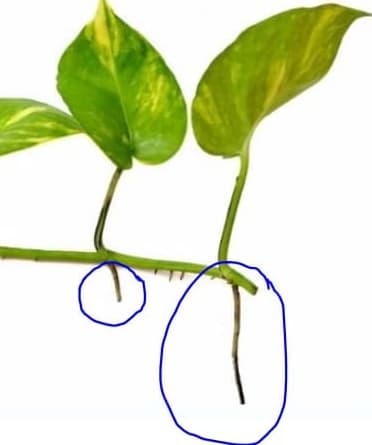
Disease-free
A disease-free plant is mandatory in case of propagation. A disease-free plant will be free from any kind of spot, dark lesion, damping-off wilting or any kind of yellowish syndrome. It will show a clear look and you have to choose such a plant.
Step 2: Cutting
Cutting is the next portion after selecting the mother plant. In this case, you have to be conscious. You should use a sharp pair of scissors to cut the stem part. Nodes (the place where the leaf is adjusted to the stem) should be present for root initiation.
The presence of two or three nodes is enough in a cut stem. Leaves should be removed with a knife or scissors from the below portion of the cutting.

Step 3: Placing in the Jar
A clean and clear jar is needed for the cut parts of the stem. This will help you to notice the root formation of the new baby plant.
Clean water should be placed in the jar and then the stem parts should be submerged in the water. Nodes should be dipped in the water.

Step 4: Adjust with the Environment
The jar should be placed in such an environment where it can get bright but indirect light and perfect temperature.
Around two weeks may take for root formation in the cut stem parts.

Let’s explore the step by step guide to Philodendron Selloum Propagation.
Steps Necessary to Support your Plant Growth in Water
Here are some steps for decent growth of your pothos plant in water.
- Use of Liquid Fertilizer: To facilitate the growth rate of a pothos plant, you should use liquid fertilizer. It is the true form of fertilizer that can be diluted easily in the water medium. In this case, the water uptaken by the newborn roots will be full of nutrient molecules that will give all kinds of support for plant survival and growth.
- Changing Water: The water should be changed regularly with an interval of one to two weeks. That’s because the water may be polluted by any means like algae or any kind of microbial growth.
- Keeping the Jar Clean: You should keep the jar clean. The jar wall should be mobbed regularly. The jar should be made of glass apparatus as sometimes plastic jars may chemically react with fertilizers.
It should be placed in such a corner so that it may remain free from excessive dust and other nasty materials.
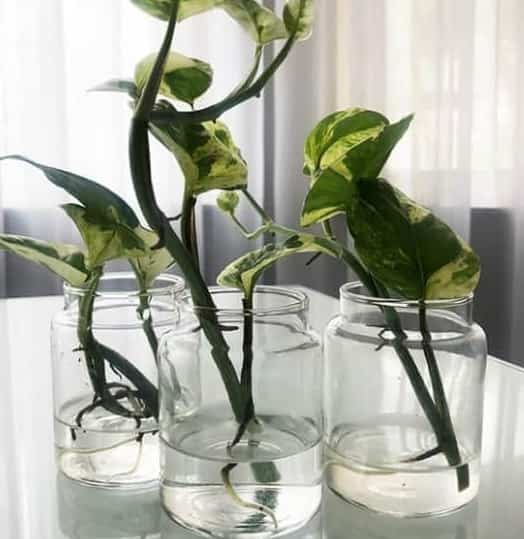
How long does it take to propagate pothos in water?
Around 2 weeks are needed to propagate pothos in water. When a stem cutting is placed in water, the root initiation is developed faster compared to the soil medium. The healthy nodes of the stem may easily form their appearance as adventitious roots.
The propagation procedure should be conducted in a skilled hand so that the nodes may not get injured by any means and root initiation will be very easy.
May Propagation in Water be Unsuccessful?
Well, this is an unfortunate but rare case. Normally root initiation is successful in most cases if you may cover the entire surroundings helpful for root formation. But still, a very small number of cuttings may not turn into a new plant.

Causes of Failure of Rooting
Rooting may be failed because of the following reasons-
The Problem in the Mother Plant
The mother plant is the main precaution of propagation because you are supposed to be going to create a new plant of the same characteristics that the mother plant possesses. If you can not choose it properly, root initiation may be devastated. Mother plant problems may be of two types.
Unhealthy
If the mother plant is not vigorous and a high adaptation ability is absent, it may not be able to grow a new plant. The pale and wilted mother plants are a great cause of rooting failure.
Immatured
You should have extreme knowledge of plant maturity. A healthy but immature plant stem cutting may fail to become a new plant. So the well-developed stem and sometimes if the aerial root is present, it shows the sign of maturity. The aerial root may be absent though having perfect maturity. So, understanding maturity is important to sort out this problem.
Disease Attack
The disease may be born in the water medium where the new pothos plant is growing. It sucks the cell sap of the plant and the plant loses its turgidity that hinders the root formation and plant development.
Let’s explore 25 amazing Pothos Varieties.
Absence of Nodes
Nodes are the places from which new roots will come out. Naturally, if you don’t put nodes along with internodes, the formation of the root is impossible.
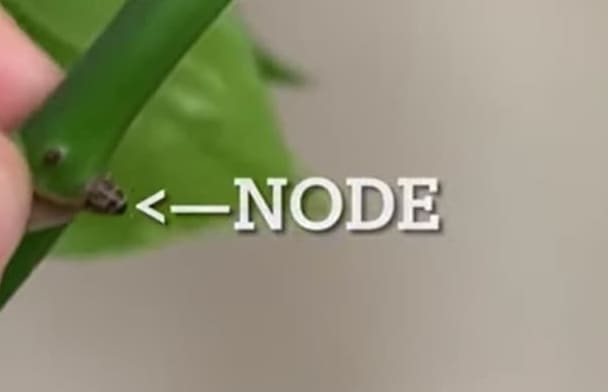
Environmental Causes
A perfect temperature of around 80 degrees Fahrenheit, bright but indirect light, medium humidity – these are common cherishments of a pothos plant. In case of failure of providing the plant with these needs, the new roots won’t come out.
Changing medium
For example, if you take a stem of a plant adjusted in the soil environment and want to propagate in water and vice-versa, this stem may not form new roots. Because the growing medium is the strength of the plant. A plant can not adapt suddenly to new surroundings.
What to Do if you Want to Switch Plant Growing Mediums?
Firstly, you should know about the term switching plant growing medium. Well, pothos plants can grow well both in water and soil. Switching medium means propagating a pothos plant in a water medium and then planting it in the soil for further nourishment or vice-versa.
This change may sometimes hinder the overall growth of the plant. But if you still are determined to change your plant medium, then you should follow a few steps.
Step 1: Growing Root In Water
Pothos plants’ roots grow faster in the water than in soil. As you are trying the water for propagating medium, so complete the procedure of propagating in water for two weeks.
Cutting from a healthy mother plant will initiate root in water in around two weeks.
Step 2: Planting In Coco Peat
Coco peat is a very important material for plant growth especially those planted as propagated material. Take a pot and fill it with coco peat. Then plant the newly rooted seedlings in that pot and put it here for one week. It will make your plant able to cope up in a solid medium by providing strength.
Step 3: Planting In Soil And Coco Peat
Now, it’s time for transplanting again. But this time, you have to plant it on a solid medium which is prepared by soil, coco peat and water. This will make your plant capable of growing in soil medium and coco peat will give strength to the plant for surviving and other nourishments.
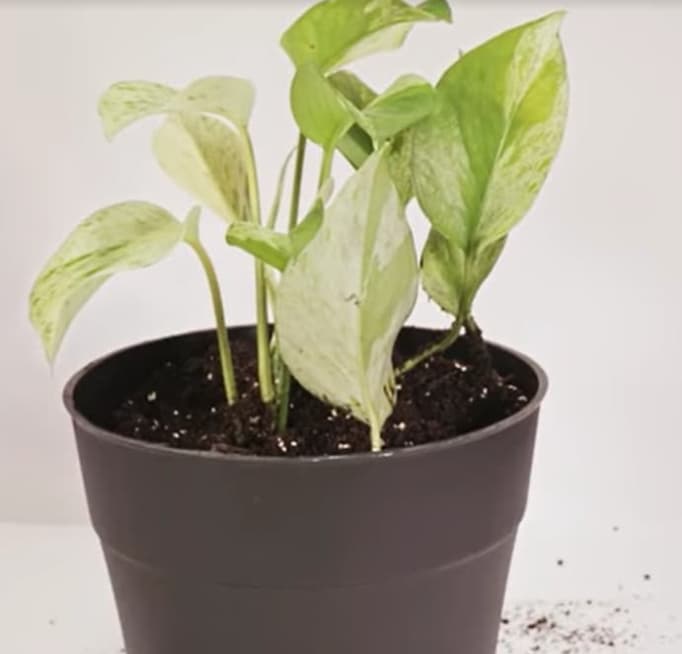
You should keep your plant in this soil and coco peat mixture for two weeks.
Step 4: Planting In Better Soil
So, this time you are having a plant that is five weeks old. Meantime, it has acquired the adaptation ability. Though the plant may not have the proper survival ability as the other pothos plants which are grown in soil from the very beginning, still it will have a strong growth rate in the proper environment along with intense care.
Special Tricks To Encourage Root Growth
Use Of Rooting Hormone
Rooting hormone is normally used to facilitate root commencement. But a pothos plant generally doesn’t require it. This plant is capable of producing roots itself. But still, if you want to apply rooting hormone, you can.
Use Of Another Plant Cutting
Using a cutting of another plant may fasten root initiation. This may be of any kind of plant. But if you put one or two cuttings of other plants with the pothos plant cutting in the same jar, it will help to grow roots faster than other jars having only pothos stem.
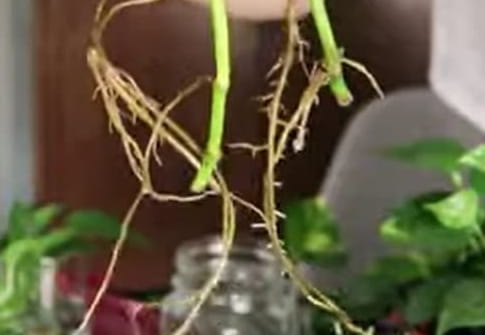
Disease Management
Generally, pothos plants face some insect attacks. Of them mealybug and scale are common. But apart from them, caterpillars, mites etc. also disturb plants’ life cycle. The disease management system should be known to you for the healthy initiation of root and plant development.
Mealybug
Mealybug is a common threat to the pothos plant development. It is one kind of pest that sucks the cell sap of the plant. The nutrient of the plant is taken by the bugs. As a result, the pothos plant can not get proper nutrients and minerals and the overall growth is devastated.
Solution
Mealybug can be resisted by using insecticides. Liquid insecticides may be sprayed or applied on the affected surface of the plant. Thus the plant will remain free from bug attacks.
Scale
Scale insect is another term of disaster for a pothos plant. Normally these pests tear the beautiful leaves and other parts of plants and make their constituents disorganized. As a result, the foliage part of the pothos plant loses its whole beauty.
Solution
Scale insects may also be controlled by insecticides. Applying gently on the leaf surface or spraying may remove these pests.
Virus Attack
Mosaic of plants may be caused because of the virus. Normally viruses attack the chlorophyll pigments present in the leaf plastid. It breaks the pigments and as a result, the green color can not be produced. That’s why an imbalanced color combination is shown in the leaf surface and this is called mosaic.
Viruses destroy the whole color of the foliage part of a pothos plant which is the center of attraction of a pothos plant. Again, as chlorophyll is not produced, the plant fails to produce food and becomes weak and the growth retards.
Solution
Viruses can be resisted by removing the attacked plants’ parts.
Fungi Attack
Fungi attack creates spot, wilting and damping-off of a pothos plant. Powdery mildew, downy mildew are the causes of losing the beauty of a pothos plant.
Solution
Fungi are prevented by fungicides. Using the proper amount of fungicide needs skill which is very helpful for plant relief.
FAQs
1. Is propagation in the water a fast-growing process?
-Yes! Propagating in water is faster than propagating in the soil in the case of a pothos plant. But plant development or vine growth is faster in soil than in water.
2. How much time is needed for rooting?
-Generally, two weeks is enough for the outset of new roots. Sometimes it may take a week more.
3. Which is the best time for rooting?
-Springtime or summer is the best season of the year for propagation. In the case of daytime, early morning is preferable as this time will give a shiny temperature that is not harmful to the baby plant.
4. Is node mandatory for plant growth?
-Of course! Without nodes, root initiation is impossible. The new adventitious roots will come from these nodes of the stem.
5. Is growing aerial roots necessary?
-Aerial root growth will give you a sign of maturity. But this is not obligatory. Aerial roots may not arise in some pothos plants.
Final Thoughts
Pothos propagation in water is a preferable system for many gardeners. You may increase your favorite plant without spending much or without having a hassle. This method doesn’t require care for the whole day too. That means you don’t need to take stress in a busy day behind it.
Root comes out easily in the water medium. So the perfect way to propagate fast is in the water medium. As a houseplant, it holds some extra attraction.
Just follow a few steps and complete the propagation procedure easily. You will have the taste of making your garden in your own way. Happy gardening!

![How to Propagate Philodendron Xanadu [Stem Cutting & Root Division] [!EXPLAINED]](https://diaryforgardening.com/wp-content/uploads/2021/08/Philodendron-Xanadu-Propagation.jpg)

![How to propagate Cylindrical Snake plant? [Two methods-both water & soil]](https://diaryforgardening.com/wp-content/uploads/2022/04/Cylindrical-Snake-Plant-Propagation.jpg)
![How to propagate Monstera Albo? [Both soil & water medium]](https://diaryforgardening.com/wp-content/uploads/2022/04/Monstera-Albo-Propagation.jpg)
![How to propagate hoya obovata? [Explained with pictures]](https://diaryforgardening.com/wp-content/uploads/2022/10/Hoya-Obovata-propagation.webp)

